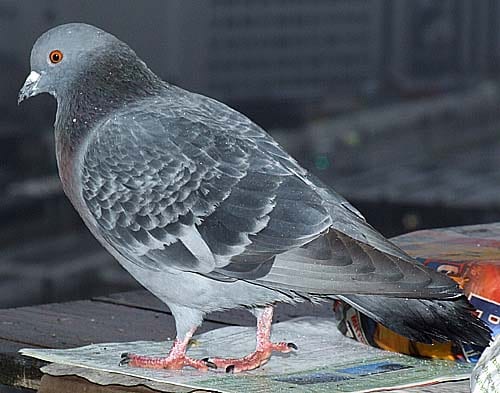
by Pigeon Patrol | Feb 22, 2022 | 4-S Gel Bird repellent, Animal Deterrent Products, Bird Deterrent Products, Bird Law, Bird Netting
Anyone who has lived in an urban environment has seen stringfoot pigeons; many wonder how the feet of these birds come to be bound and twisted, but few people seem to realize that something can be done to alleviate the suffering of these beautiful birds. Although I am a recent arrival to the world of destringing pigeons, this practice is certainly not a new phenomenon. The most perfunctory online search reveals a variety of stories from at least the last few decades of individuals who undertake pigeon destringing, and there are undoubtedly countless other individuals whose destringing activities have gone completely unnoticed and unheralded.
Not long ago I came across the intriguing case of British author and critic Naomi Lewis, noted for her animal advocacy and her pigeon rescue efforts. It isn’t clear precisely when her pigeon destringing efforts started. She moved with her family to London’s Red Lion Square in 1935 and lived there until her death in 2009; her apartment became a haven for injured creatures and famously off limits to visitors, although “she was once observed releasing a convalescent pigeon from one of the windows.”[i]An article from the London Times in 1995 commented on the plight of stringfoot pigeons in the city, and on Lewis’ activities — when the article was written, Lewis was already in her 80s: “The writer Naomi Lewis goes round London with a small pair of scissors especially to help them. She has become expert at spotting pigeons in this plight, pouncing on them, picking them up, and cutting them free.”[ii]More recently, an author once acquainted with Lewis noted her passion for rescuing stringfoot pigeons: “Luckily for them, she knew where they were. During her hours of cycling around and wandering the streets, distributing bird seed, she had learned where the crippled ones lived. Imagine her patience – the endless searching, trudging, scattering, waiting, day after day, until she eventually caught them.”[iii]The image of Lewis, an elderly, “diminutive, velvet-clad woman,”[iv]bicycling and trudging about London in search of stringfoot pigeons is compelling and inspiring. Perhaps part of what draws me to the story of Lewis is that articles that mention her (including her obituaries) suggest, in the nicest way possible, that she was quite an eccentric, and her attraction to urban pigeons seems to be one of the factors that contributed to this assessment of her character. We who love pigeons are keenly aware that this love is often equated with eccentricity.
Judging by the reactions I have seen among people on the street who witness the process of pigeon destringing, it is an activity generally perceived as eccentric, and at first the reasons it is needed and done are difficult for observers to grasp. But once these somewhat confused and often skeptical bystanders understand what is going on and why, they are just as often supportive of efforts on behalf of pigeons and some are even anxious to participate. The evidence before their eyes helps to convince observers of both the beauty of these birds and our responsibility to help them. The destringing of urban pigeons can be seen as much more, therefore, than simply an effort to assist wild creatures to have lives free of suffering. It is one more way that we pigeon champions can help to normalize the public perception of all pigeons as valued and valuable creatures.
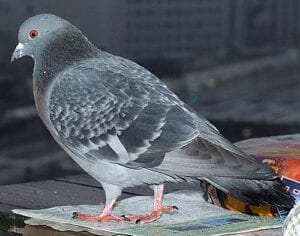
The Destringing Process in Action
What is the experience of destringing a pigeon like, and how is it done? There are many others who have been destringing for years, have handled countless stringfoot pigeons, and are so much more well-qualified than I to discuss this experience. With apologies, therefore, for my inexperience, I’d like to recount one of my own destringing experiences in San Francisco as a way of introducing the destringing process in general.
- Finding a stringfoot pigeon
Last week, a Muni failure forced me off the train at Church and Duboce. I had my destringing kit with me; I was headed for the Embarcadero, where there is a large population of stringfoot pigeons. Walking towards Market Street, I passed the Safeway parking lot and caught a glimpse of a pigeon flock there, browsing, preening, and flirting. Just in case, I stopped to check on them — and immediately spotted a beautiful white and grey girl with string on her feet, her feet bound together, barely able to walk.
- Catching the stringfoot pigeon
A crucial aspect of the destringing process is, of course, catching the pigeon. This is an acquired skill (one I am still working on), that requires much practice and patience. For those living in cities that are fortunate enough to have Stringfoot Pigeon groups, one of the best ways to learn how to catch pigeons is one-on-one expert coaching. Destringers seem to each develop their own approach to catching birds. For myself, I find that the position and disposition of the pigeon are the most important factors. I have the greatest likelihood of success if the pigeon is facing towards me (can’t easily fly away); is hemmed in by other birds; and has shifted its attention from me to the food I am dropping. After three tries and almost giving up all hope, I managed to catch this white and grey stringfoot girl.
- Destringing
The actual destringing can range from a simple process, when the string or hair is easy to see, loosely wound, and easily removed, to a monumental challenge when the material is voluminous, woven in complex layers, deeply embedded in the foot, or has already caused a lot of tissue damage and deformity. Although each case is very different, at the most basic level the process involves spraying the foot with something like Vetricyn to clean, loosen, and soften the fibers, dirt, and any dead tissue; and then very gently loosening, cutting, and unwinding fibers from the foot. Unwinding when possible instead of simply cutting helps to ensure that no hair or thread remains embedded in the skin. Fortunately for me and for this pretty pigeon, her string — which looked like a combination of twine and dental floss — was easy to see and remove, although cutting into her foot quite deeply.
- Releasing the pigeon
Of course, once the pigeon’s feet are free and disinfected, the pigeon should be released back where caught and, if possible, in sight of her flock, who she will want to join quickly in order to recount her unpleasant adventure.
- Why we do it, when we shouldn’t, and how you can help
One of the factors that motivates me to destring stringfoot pigeons seems so self-evident that it almost goes without saying: these pigeons cannot remove string from their own feet. If you take a moment to really consider this simple fact, however, the enormity of it can be overwhelming. To realize this fact is to accept the knowledge that each and every stringfoot pigeon will live their entire lives in ever-increasing pain, acquiring infections, losing digits and feet, and becoming unable to perform the basic activities required to live, unless a human sees their need, picks them up, and frees their feet.
Alongside the recognition of this need, destringers also have to realize their own limitations. Even in the brief time I have been destringing, I have seen heartbreaking examples of pigeons with deformed and painful stringfeet who I simply could not catch. The numerous destringers who have more experience than I must have countless such stories. Jodie Foreman, who started the “San Francisco Pigeons – Stringfoot help” group and several groups in other US cities, told me that when she is out but does not have her destringing kit with her, she tries to resist looking at pigeons (I believe she now carries her kit at all times!). Although it is hard to resist, there is no advantage to catching a stringfoot pigeon if one is unprepared to destring, and destringers advocate against removing any pigeon from its flock, its mate, and possibly its babies.
There are many resources available for anyone interested in helping to free the feet of these beautiful birds. The facebook group “San Francisco Pigeons – Stringfoot help” (and groups in Denver, Chicago, Washington, Seattle, and Los Angeles) provides a wealth of information about finding, catching, destringing, and the complex issues that can arise in the destringing process. Experienced destringers on these forums give generously of their time to answer questions, give advice, and provide training.
There are few forms of wildlife rescue that demand as little from the rescuer as destringing stringfoot pigeons. If you are willing to do some research, buy a handful of supplies, and you have a bit of time, you can doubtless find stringfoot pigeons in need of help near you, regardless of where you are. And it is difficult to imagine another rescue activity that can provide the same level of instantly transformative relief from pain and disability, and lasting impact on quality of life, as freeing the feet of these gentle and beautiful creatures.
Source
Pigeon Patrol Products & Services is the leading manufacturer and distributor of bird deterrent (control) products in Canada. Pigeon Patrol products have solved pest bird problems in industrial, commercial, and residential settings since 2000, by using safe and humane bird deterrents with only bird and animal friendly solutions. At Pigeon Patrol, we manufacture and offer a variety of bird deterrents, ranging from Ultra-flex Bird Spikes with UV protection, Bird Netting, 4-S Bird Gel and the best Ultrasonic and audible sound devices on the market today.
Voted Best Canadian wholesaler for Bird Deterrent products ten years in a row.
Contact us at 1- 877– 4– NO-BIRD, (604) 585-9279 or visit our website at www.pigeonpatrol.ca
Pigeon/Pigeon Patrol / Pigeons Roosting / Vancouver Pigeon Control /Bird Spikes / Bird Control / Bird Deterrent / Pigeon Deterrent? Surrey Pigeon Control / Pest /Seagull deterrent / Vancouver Pigeon Blog / Birds Inside Home / Pigeons in the cities / Ice Pigeons/ What to do about pigeons/ sparrows , Damage by Sparrows, How To Keep Raccoons Away, Why Are Raccoons Considered Pests/ De-fence / Pigeon Nesting/ Bird Droppings / Pigeon Dropping/ woodpecker control/ Professional Bird Control Company/ Keep The Birds Away/ Birds/rats/ seagull/pigeon/woodpecker/ dove/sparrow/pidgeon control/pidgeon problem/ pidgeon control/flying rats/ pigeon Problems/ bird netting/bird gel/bird spray/bird nails/ bird guard
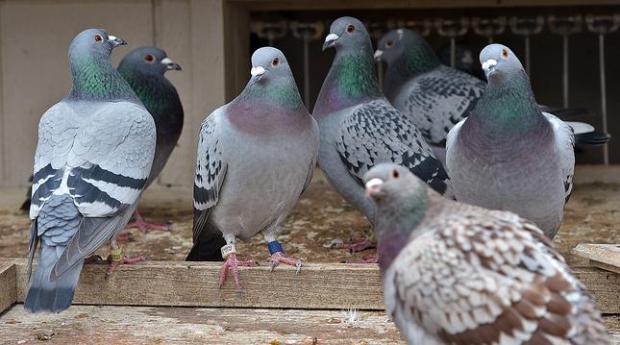
by Pigeon Patrol | Feb 7, 2022 | 4-S Gel Bird repellent, Animal Deterrent Products, Bird Deterrent Products, Bird Law, Bird Netting, Bird Spikes
Mattawa’s pigeon feeders have been warned—the free lunches stop now.
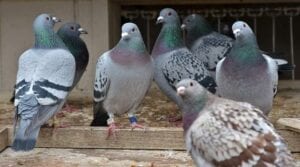
Council recently approved a bylaw prohibiting the feeding of pigeons, a ban that encompasses the entire municipality.
Cracked corn, seeds, cereal grains, wheat, and barley make delectable dishes for pigeons, and many people enjoy indulging this aviary desire to while away some time, or to make the birds’ lives a little easier.
But for Mattawa residents the practice is no longer accepted. And those who continue distributing the seed may be fined $250.
See: Pigeon poop proves a problem. Police involved
Moreover, if one attracts pigeons, and this flock results in a public nuisance, another fine of $250 can be issued. This is separate from the feeding fine. Think twice before installing that pigeon motel in your garden.
The bylaw came about after the municipality received numerous complaints regarding the birds over the past year.
“Pigeons are destroying rooftops, property, and our beautiful downtown area with their feces,” explained Councillor Loren Mick, in his report to council.
“The biggest problem” he noted is also the most preventable: “people feeding them.”
Hence the bylaw to remove “unwanted pigeon pests,” which will “promote the use and enjoyment of property in a healthy and sanitary manner.”
Source
Pigeon Patrol Products & Services is the leading manufacturer and distributor of bird deterrent (control) products in Canada. Pigeon Patrol products have solved pest bird problems in industrial, commercial, and residential settings since 2000, by using safe and humane bird deterrents with only bird and animal friendly solutions. At Pigeon Patrol, we manufacture and offer a variety of bird deterrents, ranging from Ultra-flex Bird Spikes with UV protection, Bird Netting, 4-S Bird Gel and the best Ultrasonic and audible sound devices on the market today.
Voted Best Canadian wholesaler for Bird Deterrent products ten years in a row.
Contact us at 1- 877– 4– NO-BIRD, (604) 585-9279 or visit our website at www.pigeonpatrol.ca
Pigeon/Pigeon Patrol / Pigeons Roosting / Vancouver Pigeon Control /Bird Spikes / Bird Control / Bird Deterrent / Pigeon Deterrent? Surrey Pigeon Control / Pest /Seagull deterrent / Vancouver Pigeon Blog / Birds Inside Home / Pigeons in the cities / Ice Pigeons/ What to do about pigeons/ sparrows , Damage by Sparrows, How To Keep Raccoons Away, Why Are Raccoons Considered Pests/ De-fence / Pigeon Nesting/ Bird Droppings / Pigeon Dropping/ woodpecker control/ Professional Bird Control Company/ Keep The Birds Away/ Birds/rats/ seagull/pigeon/woodpecker/ dove/sparrow/pidgeon control/pidgeon problem/ pidgeon control/flying rats/ pigeon Problems/ bird netting/bird gel/bird spray/bird nails/ bird guard

by Pigeon Patrol | Feb 2, 2022 | 4-S Gel Bird repellent, Animal Deterrent Products, Bird Deterrent Products, Bird Law, Bird Netting, Bird Spikes
Birds are frequent sources of emerging human infectious diseases. Viral particles were enriched from the feces of 51 wild urban pigeons (Columba livia) from Hong Kong and Hungary, their nucleic acids randomly amplified and then sequenced. We identified sequences from known and novel species from the viral families Circoviridae, Parvoviridae, Picornaviridae, Reoviridae, Adenovirus, Astroviridae, and Caliciviridae (listed in decreasing number of reads), as well as plant and insect viruses likely originating from consumed food. The near full genome of a new species of a proposed parvovirus genus provisionally called Aviparvovirus contained an unusually long middle ORF showing weak similarity to an ORF of unknown function from a fowl adenovirus. Picornaviruses found in both Asia and Europe that are distantly related to the turkey megrivirus and contained a highly divergent 2A1 region were named mesiviruses. All eleven segments of a novel rotavirus subgroup related to a chicken rotavirus in group G were sequenced and phylogenetically analyzed. This study provides an initial assessment of the enteric virome in the droppings of pigeons, a feral urban species with frequent human contact. 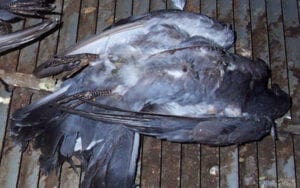
Source
Pigeon Patrol Products & Services is the leading manufacturer and distributor of bird deterrent (control) products in Canada. Pigeon Patrol products have solved pest bird problems in industrial, commercial, and residential settings since 2000, by using safe and humane bird deterrents with only bird and animal friendly solutions. At Pigeon Patrol, we manufacture and offer a variety of bird deterrents, ranging from Ultra-flex Bird Spikes with UV protection, Bird Netting, 4-S Bird Gel and the best Ultrasonic and audible sound devices on the market today.
Voted Best Canadian wholesaler for Bird Deterrent products ten years in a row.
Contact us at 1- 877– 4– NO-BIRD, (604) 585-9279 or visit our website at www.pigeonpatrol.ca
Pigeon/Pigeon Patrol / Pigeons Roosting / Vancouver Pigeon Control /Bird Spikes / Bird Control / Bird Deterrent / Pigeon Deterrent? Surrey Pigeon Control / Pest /Seagull deterrent / Vancouver Pigeon Blog / Birds Inside Home / Pigeons in the cities / Ice Pigeons/ What to do about pigeons/ sparrows , Damage by Sparrows, How To Keep Raccoons Away, Why Are Raccoons Considered Pests/ De-fence / Pigeon Nesting/ Bird Droppings / Pigeon Dropping/ woodpecker control/ Professional Bird Control Company/ Keep The Birds Away/ Birds/rats/ seagull/pigeon/woodpecker/ dove/sparrow/pidgeon control/pidgeon problem/ pidgeon control/flying rats/ pigeon Problems/ bird netting/bird gel/bird spray/bird nails/ bird guard
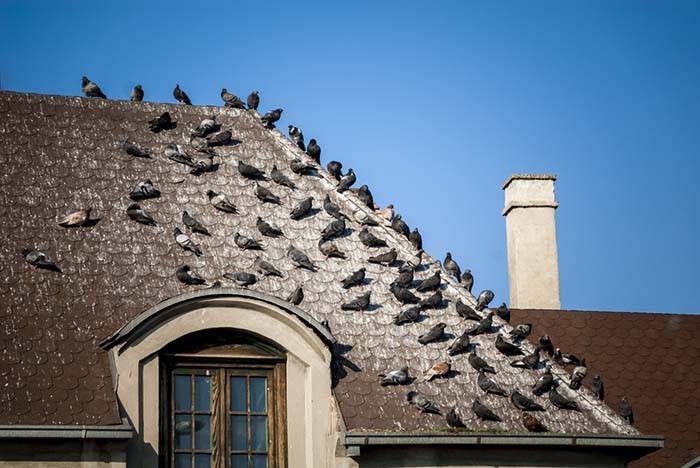
by Pigeon Patrol | Jan 25, 2022 | 4-S Gel Bird repellent, Animal Deterrent Products, Bird Deterrent Products, Bird Law, Bird Netting, Bird Spikes
It was the satirist Tom Lehrer who started the rot in 1959 with his song Poisoning Pigeons in the Park, which explained that it takes only a smidgen of strychnine and “it’s not against any religion to want to dispose of a pigeon” (though I doubt that many Buddhists or Jains would agree).
However, Woody Allen delivered the coup de grâce in his 1980 film Stardust Memories, when he referred to feral pigeons as “rats with wings”.
The term had first appeared in 1966 in an article in The New York Times, but Allen’s film reached a much wider audience. It was the final nail in the coffin for these birds – what could be more damning than to be on a par with rats? Ever since, feral pigeons have been one of the Disgusting Three, together with North American grey squirrels (‘tree rats’) and rats themselves. Their fall from grace was dramatic and, amazingly, took just a couple of decades.
Where did feral pigeons come from?
The rock pigeon Columba livia was the wild ancestor of the feral pigeon and the first bird to be domesticated, in the Middle East some 6,000 years ago. Since then its contribution to human wellbeing has been astonishing.
Until agricultural advances in quite recent times, a dovecote, rabbit warren and carp pond were the three essentials to provide fresh meat throughout the year in Europe. In addition to food, pigeons produced valuable guano so rich in nutrients that one load of it was worth 10 from any other species. In many countries, pigeon dung actually played a key part in agricultural development.
It might seem improbable that the rock pigeon, a relatively uncommon species of remote cliffs, was the first bird we domesticated. But this process did not involve capture and selective breeding – merely the provision of an alternative place to nest, usually a dovecote with rows of ledges or clay pots along its internal walls. Some designs could accommodate several thousand sitting females.
The pigeons themselves were given little food, generally flying off to forage elsewhere. Despite requiring minimal attention, each pair typically produced about 10 squabs a year. Pigeons were thus the perfect source of protein.
Darwin loved pigeons
The reliance on pigeons for food declined when it became clear that chickens were more suited to mass production. But the interest in breeding them remained: much of the first chapter of On The Origin of Species is devoted to pigeons, where Darwin describes the many breeds that can be created artificially.
Today, though, the pastimes of rearing and racing pigeons are waning in popularity. Both hobbies require a great deal of patience and dedication – commodities in short supply in the modern world.
Though pigeons were still an important food source in the 1800s, they were being stolen from lofts in large numbers to supply the newly fashionable sport of pigeon shooting: they were used as live targets in competitions.
The Hurlingham Club in London was founded in 1869 expressly for pigeon shooting. When the practice was made illegal in 1921, clay pigeon shooting was invented.
Apart from supplying us with food, fertiliser and fun, pigeons have also played a useful role in medicine. Prolactin, the hormone responsible for milk production in mammals, was first isolated in 1933 in pigeons; the same hormone stimulates the male and female birds to secrete ‘milk’ from their crops to feed their young.
Pigeons in war and peace
But pigeons are probably most famous for their ability to find their way home and deliver messages. This was first exploited 3,000 years ago, and by the fifth century BC Syria and Persia had widespread networks of message-carrying pigeons.
In 1850, Paul Julius Reuter’s fledgling news service used homing pigeons to fly the 120km between Aachen and Brussels, thereby laying the foundations for a global news agency, and the world’s first ‘airmail’ stamps were issued for the Great Barrier Pigeon-Gram Service.
The birds’ homing ability was harnessed in the two world wars: in the early 1940s, the American Signal Pigeon Corps consisted of 3,150 soldiers and 54,000 birds. Some 90 per cent of the messages got through. And these avian secret agents saved countless lives, too – of 54 Dickin Medals (the animal’s VC) awarded in World War II, 32 went to pigeons.
Feral pigeon in front of Lincoln Cathedral. © Oksana Kachkan/Getty
Are messenger pigeons still used anywhere?
Even now, homing pigeons remain a useful means of communication in remote areas. The Police Pigeon Service in Orissa, India, was retired only in 2002.
We are all beguiled by the internet, yet in 2009, as part of a PR stunt, a pigeon carried a 4GB memory stick 80km in South Africa; the country’s biggest internet service provider managed to transfer just 4 per cent of the data on the stick in the same time. Perhaps it’s hardly surprising that the Taliban banned people from keeping or using homing pigeons in Afghanistan.
Amazingly, despite decades of research, we are still not sure how pigeons find their way home over terrain they have never seen before, and with such apparent ease. Partly this confusion is because different breeds appear to rely on different cues.
The consensus is that pigeons use the sun and/or the Earth’s magnetic field on long journeys, with visual cues becoming important near their loft, though recent studies suggest that they may also use odours. Not bad for birds with very small brains.
Urban pigeon outcasts
The list goes on and on: the feral pigeon has contributed to civilisation in more ways than any other species of bird. So how – and, perhaps more importantly, why – has it become such a pariah?
The fundamental reason is that modern technology has rapidly reduced our reliance on pigeons. All that most people see today are the flocks of feral birds found in cities on every continent except Antarctica, the most obvious surviving trace of the close association between people and pigeons spanning several millennia.
It’s no wonder that feral pigeons thrive in urban areas. Buildings are perfect nest sites for these exiles, mimicking the windswept cliffs used by their ancestors. There can be few more stirring sights than masses of pigeons swooping above our city streets, occasionally with peregrines in hot pursuit.
Pigeons as tourist attractions
So it is difficult to see why feral pigeons are now so widely reviled. After all, they’re among the few birds that the average city-dweller sees regularly.
Lots of people enjoy their interactions with these charming birds, which have long drawn the crowds in tourist hotspots such as London’s Trafalgar Square and Venice’s Piazza San Marco.
And let’s not forget that feral pigeons are some of the most beautiful birds you could hope to see. Their plumage has a multitude of different colours, including metallic greens, bronzes and purples on the neck, as well as exquisite wing patterns.
Interestingly, most feral animals quickly revert to the appearance of their wild ancestors. All British mink, for instance, are now the same shade of brown as their wild relatives in North America, even though the original escapees from fur farms had a plethora of coat colours bred for the fur trade.
We don’t know why pigeons are the only feral animals to have retained the varied coloration of their domesticated ancestors.
Are feral pigeons a pest and a nuisance?
It is often said that feral pigeons are a real nuisance, but what exactly are the problems? The standard gripe is that there are too many of them and therefore they need to be controlled. It’s a familiar refrain. The accusation is also levelled at rats, magpies, crows, squirrels, foxes, badgers and deer, to name but a few so-called ‘pests’.
Of course, no one ever says what the ideal number of feral pigeons is, just that there are too many. However, there have been a handful of detailed population estimates, including one in Sheffield: 12,130 feral pigeons in a city of half a million people. This is likely to be typical of our cities.
The BTO’s Garden BirdWatch survey listed the feral pigeon as the 25th most frequently recorded species in the first quarter of 2010, whereas the wood pigeon was number five and the collared dove number eight.
Feral pigeons are also said to be ‘dirty’ because they foul streets and buildings. Personally, I find pigeon droppings much less offensive than graffiti, the chewing gum stuck on pavements and bus seats, and the masses of litter everywhere.
Picking up all of the filth left by people costs vastly more than removing pigeon poo. Likewise, protecting buildings from pigeons costs considerably less than cleaning up after domestic dogs.
Do pigeons carry disease?
Many websites list the diseases recorded in feral pigeons. How very scary. But let’s put this in context – many more diseases are known in people and their pets. Moreover, all animals carry diseases: the key issue is how often they transfer to humans, and there is little evidence of this happening with feral pigeons.
Plus, domestic pigeons often come into contact with feral pigeons but stay perfectly healthy. In other words, feral pigeons simply do not pose a significant health risk. It’s a non-issue.
In November 1855, Charles Darwin, arguably the most famous pigeon fancier of them all, sent a letter to his great friend the geologist Charles Lyell, who was about to pay him a visit. Darwin wrote: “I will show you my pigeons! Which are the greatest treat, in my opinion, that can be offered to a human being.”
How right he was!
FERAL PIGEON TERMINOLOGY: Wild, domestic or feral?
Feral pigeons live worldwide, but their wild ancestors are rare and in retreat. It’s important to get your terminology right when discussing pigeons.
Feral pigeons (sometimes called city, town or street pigeons) are descended from birds that escaped from dovecotes or other captive situations. In turn, domesticated pigeons were bred from wild rock pigeons (a species formerly known as the rock dove, but renamed in 2004).
Feral pigeons live in urban areas on every continent except Antarctica, with a global population numbering in the millions. By contrast, wild rock pigeons are now confined to outlying Scottish islands and remote parts of the Mediterranean, North Africa and western Asia.
But since it is hard to tell feral from wholly wild birds, and hybridisation is rife, it is difficult to map their respective populations accurately.
A day in the life of a city pigeon
The daily routine of a pair of pigeons in central London might look like this…
02.00 The pigeons are roosting side by side on their windowsill nest near Trafalgar Square. Their two eggs hatched a day ago.
06.00 At dawn, the female flies to the square to find food. Meanwhile, her mate gives their chicks some of his rich crop milk.
09.00 The female joins a feeding frenzy as seed is scattered (illegally) by a pigeon lover, before a warden moves the birds on.
11.00 Back at the nest, the female greets her partner with a cooing and bill-rubbing display. He then heads to St James’s Park to be fed by office workers having lunch.
15.00 After preening one another, the pair mate briefly at the nest. The female leaves again, while the male broods the squabs.
20.00 Reunited on their window ledge, the adult pigeons coo and bill-rub together before settling down for the night.
DID YOU KNOW?
- Pigeon ‘milk’ is a cottage cheese-like fluid secreted from the lining of the crop. Flamingos are the only other birds to feed their young this way.
- Experiments have shown that the humble feral pigeon can be trained to distinguish music by Bach and Stravinsky, and paintings by Monet and Picasso.
Source
Pigeon Patrol Products & Services is the leading manufacturer and distributor of bird deterrent (control) products in Canada. Pigeon Patrol products have solved pest bird problems in industrial, commercial, and residential settings since 2000, by using safe and humane bird deterrents with only bird and animal friendly solutions. At Pigeon Patrol, we manufacture and offer a variety of bird deterrents, ranging from Ultra-flex Bird Spikes with UV protection, Bird Netting, 4-S Bird Gel and the best Ultrasonic and audible sound devices on the market today.
Voted Best Canadian wholesaler for Bird Deterrent products ten years in a row.
Contact us at 1- 877– 4– NO-BIRD, (604) 585-9279 or visit our website at www.pigeonpatrol.ca
Pigeon/Pigeon Patrol / Pigeons Roosting / Vancouver Pigeon Control /Bird Spikes / Bird Control / Bird Deterrent / Pigeon Deterrent? Surrey Pigeon Control / Pest /Seagull deterrent / Vancouver Pigeon Blog / Birds Inside Home / Pigeons in the cities / Ice Pigeons/ What to do about pigeons/ sparrows , Damage by Sparrows, How To Keep Raccoons Away, Why Are Raccoons Considered Pests/ De-fence / Pigeon Nesting/ Bird Droppings / Pigeon Dropping/ woodpecker control/ Professional Bird Control Company/ Keep The Birds Away/ Birds/rats/ seagull/pigeon/woodpecker/ dove/sparrow/pidgeon control/pidgeon problem/ pidgeon control/flying rats/ pigeon Problems/ bird netting/bird gel/bird spray/bird nails/ bird guard
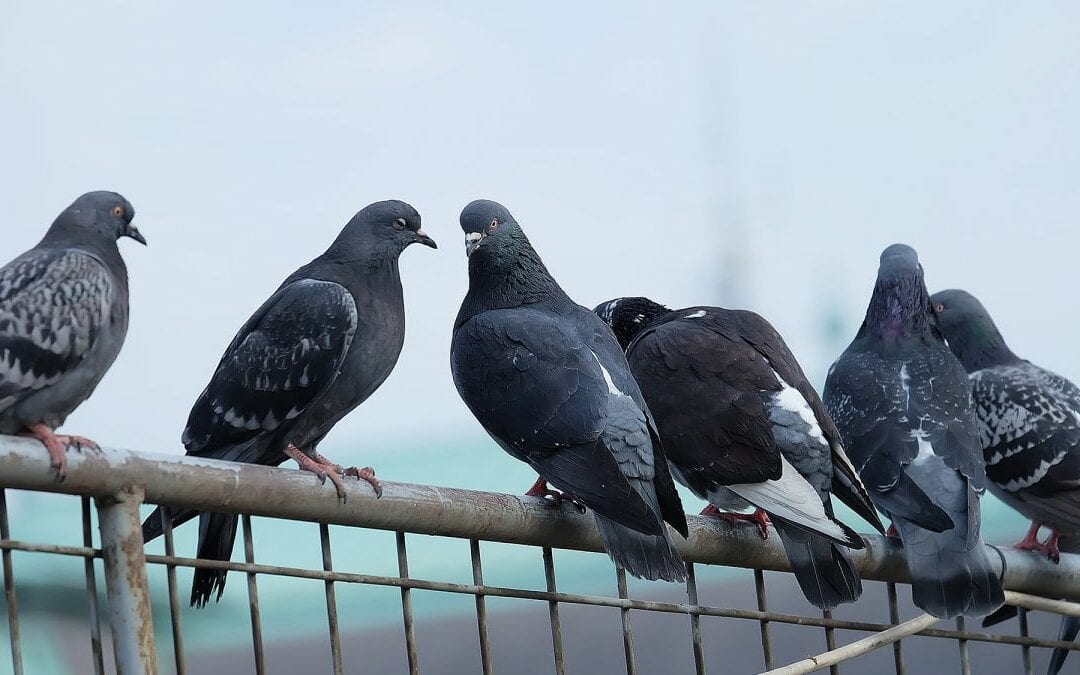
by Pigeon Patrol | Jan 4, 2022 | Bird Deterrent Products, Bird Law, Bird Netting, Bird Spikes, Columbidae
Did you find a pigeon nest with eggs in the geranium pot on the balcony? I bet that’s why you’re reading this article. Maybe you’re wondering what to do with it.
Do you keep it? Can you touch the pigeon eggs? Should you feed the mother bird?… Well, think again.
What should be done if you find a pigeon’s nest on your balcony?
If you find a pigeon’s nest on your balcony, the best thing to do is to get rid of it. Pigeons represent a severe health hazard for you and your loved ones. Do not touch it with your bare hands. Wear a pair of gloves, and remove it from your balcony.
Get rid of the nest together with its eggs. In order to discourage the mother to return to the nest, try placing a toy snake where you found the nest. Hopefully, this will scare the bird for a while.
Am I too cruel? Probably. However, as much as I love animals, in this specific case, I have no doubts: get rid of the nest and the eggs as fast as you can! Let me explain why.
Are pigeons dangerous?
Pigeons, especially those who live in the city, are carriers of diseases that sometimes can be very serious. They are not the kind of animal you want to keep as a pet on your balcony.
Not to mention how messy they are! Yes, you guessed it right. I am talking about their infamous droppings. Worthwhile mentioning it, three primary diseases are associated with pigeons that are dangerous for humans: Histoplasmosis, Cryptococcosis, and Psittacosis. Let’s explore this topic a little bit more.
HISTOPLASMOSIS:
Histoplasmosis is an infection caused by breathing in the spores of a fungus found in bird droppings. This disease affects the lungs. You can catch this disease by inhaling the spores in the air while performing cleaning jobs or any other type of project (such as renovations or demolitions) that can raise high levels of spores in the air, . The majority of people are asymptomatic; however, Histoplasmosis can be dangerous for those with a compromised immune system, such as infants and the elderly. As I said before, the majority of people won’t develop any symptoms, however, when the infection is severe, it can lead to a high fever, chest pains, and fatigue.
Some people can develop a chronic form of Histoplasmosis, which includes a bloody cough, mimicking symptoms of tuberculosis. If untreated, this disease could be fatal.
CRYPTOCOCCOSIS:
Cryptococcosis is caused by a fungus known as Cryptococcosis neoformans. It is a disease that affects the lungs and is associated with pigeon droppings, soil, and unwashed fruit. This disease is contagious and can spread from person to person. Generally, healthy people won’t develop any symptoms, but people with a compromised immune system such as elderly or infants are at a higher risk for contracting the disease. This infection attacks mostly the lungs, with minimal symptoms. In some rare cases, however, it can spread to the brain, the urinary tract, and the bones. When the infection reaches the brain, it can lead to meningitis and other serious complications.
PSITTACOSIS:
Psittacosis is also known as Ornithosis or Parrot Fever. It is an infection caused by a Chlamydia Psittaci, a fungus present in bird droppings. People can catch the disease by inhaling the fungus spores that are in the air. Symptoms can vary from headache, fever, dry cough, and pneumonia. People who are most affected by this disease are pet shop owners, workers in aviaries, and veterinary facilities. Psittacosis cannot be transmitted from person to person.
If the above still hasn’t convinced you, here is a list that will change your mind. You really don’t want to keep these pesty birds anywhere near you. Besides being disgusting, pigeon droppings are corrosive and can cause significant damage to roofs and balconies. It is also really difficult to scrap it from floors, and most probably will leave a stain if not cleaned in time. Also, the droppings are really hard to remove from smooth surfaces such as your car, the patio floor, but also from your clothes and your shoes.
The droppings can attract other unwelcome guests to your premises, such as flies and rats. Pigeons might cause damage to your vegetable garden. These birds are territorial and will scare smaller beneficial birds such as hummingbirds. They tend to return from season to season, which makes it very challenging to chase them away.
Well, now that I have convinced you to dispose of the pigeon’s nest with its eggs, comes the messy part: how to clean the balcony from pigeon droppings.
How to clean pigeon droppings
Generally speaking, cleaning windows and windowsills does not pose a health risk to you or to your family. However, you will need to take some precautions such as:
- Wearing disposable gloves and a mask
- Wearing closed-toe shoes
- Washing your clothes immediately after dealing with the droppings
- If you are thinking of scraping the dropping, wet them beforehand, to prevent inhaling the fungus spores that float in the air.
- Brush with warm soapy water. Where needed, you can add some baking soda to the soapy water solution. Throw away the brush or the sponge-cloth that you used for cleaning.
- Rinse thoroughly with a hose.
As I said before, pigeons will return, and once they spot your balcony as their favorite nesting place, you are doomed. They will return every season and nest there.
How do you tell if a pigeon is going to lay eggs in your balcony?
As soon as spring comes, around March/April, pigeons begin to look for air vents, vases, hidden corners on the terraces to establish their nest and create a family. You will surely notice a continuous flutter forward and backward. It’s the parents which take turns as soon as they establish their nest.
It will be challenging to move them. These birds will remember your house and will want to go back for generations.
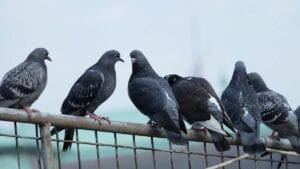
How to get rid of pigeons & How to prevent them from returning to your home
The secret to prevent pigeons from returning to your house is to make their landing place as inconvenient as possible. This is what you can do to scare pigeons off your property and to prevent from nesting in the future:
- Install some anti-roosting spikes. They are by far the most effective pigeon deterrents. I found them on Amazon and are pretty easy to install.
- Install a bird deterrent gel that is commercially available and that works on a multi-sensory level using sight, smell, and touch. This gel makes the surface where the pigeon lands very sticky.
- Install a wind chime on your balcony or your patio.
- Fasten some aluminum foil strings on your balcony railings.
- Put a decoy crow on your roof. Move the crow from time to time as pigeons are very clever and they will get use to it.
- Put a screen over attic vents, chimneys, and anywhere they can create a nest.
- Put a toy snake on your balcony or the place where they might build their nest. Once I made my own decoy DIY snake from a souvenir alligator head from Florida. I filled a black sock with some clothes and slipped it on the alligator’s head. (A word of advice: as time passes, just remember where you placed the snake… it might suddenly scare you to death when you least expect it! I am speaking from experience!)
I hope I have convinced you that pigeons are messy and also carry parasites. You won’t regret getting rid of their nest. Besides, have you ever seen what pigeon chicks look like? They are the scariest chicks ever!!
Source
Pigeon Patrol Products & Services is the leading manufacturer and distributor of bird deterrent (control) products in Canada. Pigeon Patrol products have solved pest bird problems in industrial, commercial, and residential settings since 2000, by using safe and humane bird deterrents with only bird and animal friendly solutions. At Pigeon Patrol, we manufacture and offer a variety of bird deterrents, ranging from Ultra-flex Bird Spikes with UV protection, Bird Netting, 4-S Bird Gel and the best Ultrasonic and audible sound devices on the market today.
Voted Best Canadian wholesaler for Bird Deterrent products ten years in a row.
Contact us at 1- 877– 4– NO-BIRD, (604) 585-9279 or visit our website at www.pigeonpatrol.ca
Pigeon/Pigeon Patrol / Pigeons Roosting / Vancouver Pigeon Control /Bird Spikes / Bird Control / Bird Deterrent / Pigeon Deterrent? Surrey Pigeon Control / Pest /Seagull deterrent / Vancouver Pigeon Blog / Birds Inside Home / Pigeons in the cities / Ice Pigeons/ What to do about pigeons/ sparrows , Damage by Sparrows, How To Keep Raccoons Away, Why Are Raccoons Considered Pests/ De-fence / Pigeon Nesting/ Bird Droppings / Pigeon Dropping/ woodpecker control/ Professional Bird Control Company/ Keep The Birds Away/ Birds/rats/ seagull/pigeon/woodpecker/ dove/sparrow/pidgeon control/pidgeon problem/ pidgeon control/flying rats/ pigeon Problems/ bird netting/bird gel/bird spray/bird nails/ bird guard

by Pigeon Patrol | Jan 4, 2022 | Bird Deterrent Products, Bird Law, Bird Netting, Bird Spikes, Columbidae, Doves
In the UK, pigeons seem to be everywhere you go and if you find them on your roof – at home or work – chances are, you’ve heard them too. Not only are pigeons notoriously noisy but they can create a whole lot of mess and expensive damage to your roof tiles. What’s more, their faeces can carry diseases and draw vermin such as flies and rats to your property, which can leave you with yet another problem.
How to get rid of pigeons/birds: Can home remedies work?
There are some widely recommended home remedies to get rid of pigeons and other birds, but these are generally ineffective in practice.
Can spices get rid of pigeons?
Spices such as chilli powder, pepper and cinnamon have been touted as pigeon/bird repellents. Unfortunately, they’re far from an effective solution – you’ll also need to apply them very frequently as they get washed away with rain and lose their potency. Going up to your roof every weekend to sprinkle more seasoning is less than ideal, to say the least.
Do decoy birds of prey scare pigeons?
Decoy statues of birds of prey or lightweight kites have been known to be used as pigeon/bird deterrents to try and stop pigeons nesting on your roof. That said, even if you do initially have success with decoys they will only be effective for a short period of time because birds get used to their fixed placement – and when the birds approach they will see that they’re just an object.
Will spreading sticky stuff get rid of pigeons?
Sticky substances, such as an environmentally safe commercial gel-repellent or honey, are another temporary solution that’s been tried to prevents pigeons and other birds from perching on your roof, due to its slippery layer.
Just as with the spices, however, this method must be reapplied to maintain its effectiveness – and it’s not very effective in the first place. It’s not only inconvenient but also potentially dangerous to keep going on your roof, as you could hurt yourself and possibly damage your roof even further. If you’re unsure, speak to the experts who can keep birds away from your roof.
Spraying pigeons with water
For a solution which works all of two minutes, you can spray pigeons with a water hose. This is method simply scares them away for the time being but they’ll happily return in no time to nest on your roof again.
How to keep pigeons away from your garden
Ultrasonic devices to keep pigeons/birds away
These devices can be installed by pest control companies and are effective bird repellers that produce sound waves we humans can’t hear, but to pesky pigeons, and other birds – it’s irksome. This device can be effective and the high frequency will be a sure way to make birds find another place to reside.
Can my pets deter pigeons?
If you have a dog or cat, they may help out with the bird problem to an extent, but the odds are that the birds won’t be too put off due to the height advantage they have over your beloved pets.
Will using a scarecrow get rid of birds?
Installing a scarecrow in your front or back garden – wherever the pigeons will see this figure – is a similar idea to the bird of prey decoy. It also has a similar amount of effectiveness – very little – particularly once the birds get used to it.
Why are there pigeons on my roof?
If you’ve noticed an unusual amount of pigeons on your roof, it’s likely they have a nearby food and water source. If you’re aware of these sources, remove them – it’s important not to feed pigeons and birds if you wish to get rid of them. Pigeons and all birds in general love grass seeds, berries and your pet’s food, so consider laying fresh turf on your lawn, replace fruit bearing trees with fern, oak, pine or maple trees and keep your pet’s food indoors.
Access points to your attic might be the reason you’re seeing so many pigeons on your roof. This area provides them with the ideal breeding ground where they’re warm and safe from predators.
Basic DIY bird prevention measures
- Remove fruit-bearing trees
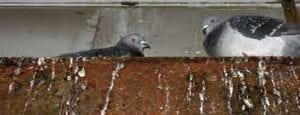
When should I call the pest professionals for bird control?
If your home remedies aren’t working, it’s important to call your local pest controllers who can put a stop to your pest peeves.
How do professionals keep birds off your roof?
- Bird netting – to prevent pigeons from colonising, bird netting is an effective method. Netting comes in a whole range of sizes so this preventative can be made suitable to any dimensions of a building. To exclude pigeons, starlings or sparrows we will ensure the grids on the netting are the optimal size to enforce the exclusion of your pest problems. This method can be used to protect building fascias, flat roofs, balconies, statues and decorative embellishments where birds can potentially nest.
- Bird spikes – are in fact a humane bird control solution and highly effective too. This piece of equipment can be installed on any linear surface, where pigeons and other birds may nest.
- Bird wire – also known as anti-pigeon wire is ideal for large establishments such as cathedrals, churches and banks offering a discrete solution that will eliminate any pigeon or bird infestation. This method has a low visual impact and will subtly tackle the problem at hand.
- Electric bird deterrent system – this is used around heavily colonised buildings and measures a discreet 8mm. Birds experience a small shock when a bird of any species lands on the building. This does not hurt the bird, it simply encourages the bird to move elsewhere.
Keeping pigeons away from your garden and balcony
Finding pigeon or any bird poop on your garden furniture, patio or balcony can be extremely irritating and hard to clean. It’s likely you will have to turn to a professional who can implement a more permanent solution.
Source
Pigeon Patrol Products & Services is the leading manufacturer and distributor of bird deterrent (control) products in Canada. Pigeon Patrol products have solved pest bird problems in industrial, commercial, and residential settings since 2000, by using safe and humane bird deterrents with only bird and animal friendly solutions. At Pigeon Patrol, we manufacture and offer a variety of bird deterrents, ranging from Ultra-flex Bird Spikes with UV protection, Bird Netting, 4-S Bird Gel and the best Ultrasonic and audible sound devices on the market today.
Voted Best Canadian wholesaler for Bird Deterrent products ten years in a row.
Contact us at 1- 877– 4– NO-BIRD, (604) 585-9279 or visit our website at www.pigeonpatrol.ca
Pigeon/Pigeon Patrol / Pigeons Roosting / Vancouver Pigeon Control /Bird Spikes / Bird Control / Bird Deterrent / Pigeon Deterrent? Surrey Pigeon Control / Pest /Seagull deterrent / Vancouver Pigeon Blog / Birds Inside Home / Pigeons in the cities / Ice Pigeons/ What to do about pigeons/ sparrows , Damage by Sparrows, How To Keep Raccoons Away, Why Are Raccoons Considered Pests/ De-fence / Pigeon Nesting/ Bird Droppings / Pigeon Dropping/ woodpecker control/ Professional Bird Control Company/ Keep The Birds Away/ Birds/rats/ seagull/pigeon/woodpecker/ dove/sparrow/pidgeon control/pidgeon problem/ pidgeon control/flying rats/ pigeon Problems/ bird netting/bird gel/bird spray/bird nails/ bird guard















